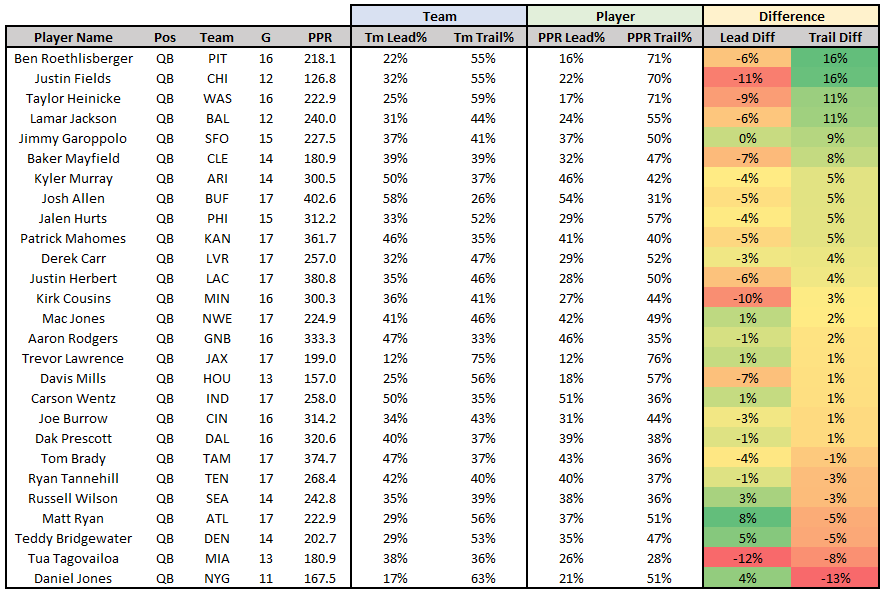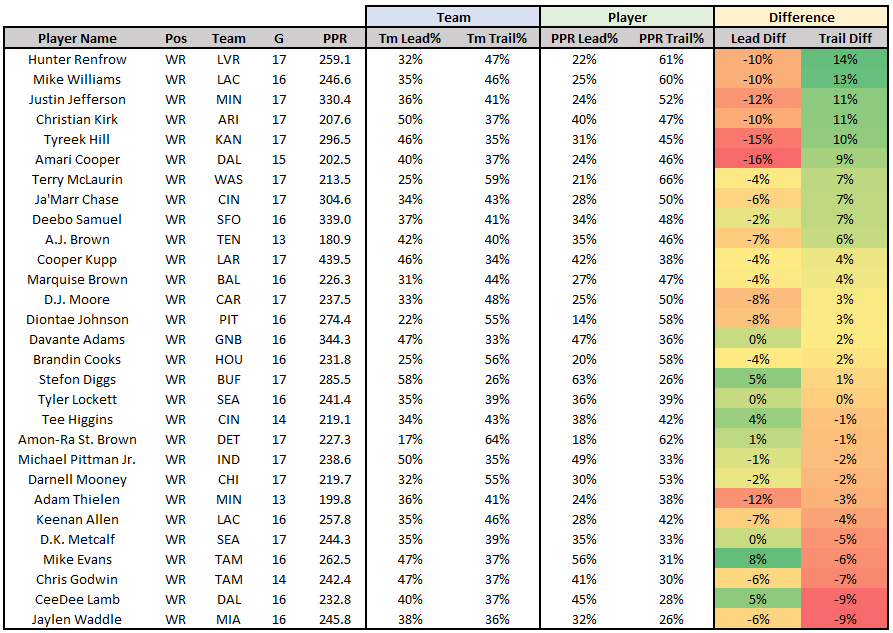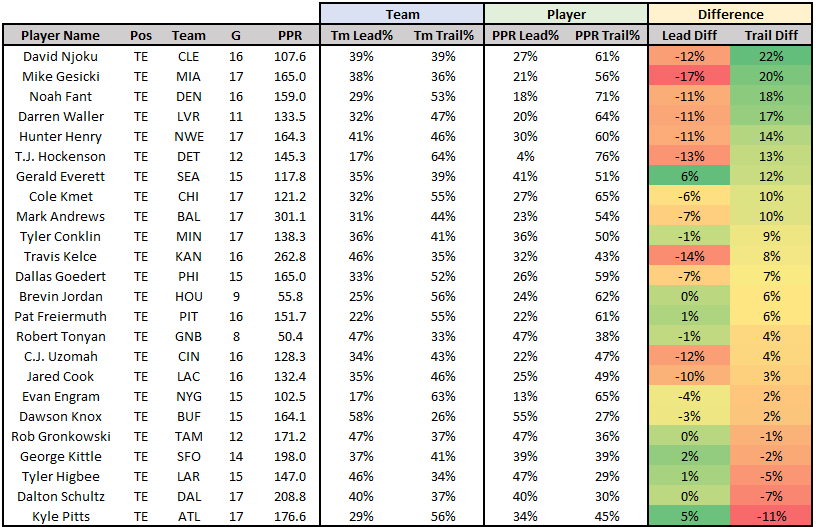Earlier this week, we took a look at last season’s most- and least-consistent fantasy players (by both production and usage). Sometimes that’s just due to luck or variance, but often enough that’s due to the specific nature of a player’s role. For instance, wide receivers who are heavily reliant on deep targets for their fantasy production are far more volatile than, say, a true low-aDOT possession receiver like Hunter Renfrow. In today’s article I wanted to focus on another oft-forgotten component to fantasy volatility — gamescript.
In each chart below, broken down by position, we’re looking at how often a player’s team was trailing or leading and each player’s fantasy splits in both categories. The difference between these numbers represents how much a player benefited from a specific gamescript (in this case, either leading or trailing). The more “gamescript-dependent” / “gamescript-sensitive” players will be the ones on either end of the chart.
By determining how gamescript dependent a player was last season, we should be able to make some educated guesses about their role next season. If a team’s quarterback scored a high percentage of his fantasy points when trailing last season, and the inverse was true for the running back, we might surmise that the team “played it safe” when ahead in games. This might mean that if this team had a game against the Buccaneers (i.e. they’re unlikely to be leading), that quarterback might be an interesting and underpriced DFS play that week. Today, we’ll be taking a look at every fantasy-relevant position but focusing mostly on quarterbacks and running backs.
Quarterbacks
It should be pretty self-evident that quarterbacks are far more productive when trailing as they are forced to throw more often, which is evidenced by the chart above. The sense of urgency to put points on the board when losing is observable in 2021 pass splits, as losing teams opted to throw on 65% of their plays on average, while winning teams passed on just 50% of their plays. Losing teams move faster as well — which means more plays and more opportunity for QB fantasy points. Take last year’s Washington team as an example — they ran plays 6.0 seconds faster when they were losing (28.2 seconds per play) compared to when they were winning (34.2).
Interestingly, most of the league’s top rushing QBs in 2021 wound up being far more effective when trailing. I think there could be a few reasons for this:
Trailing teams are forced to throw more often, which means more QB dropbacks. But rushing QBs often take off and run on QB dropbacks, which both increases the efficiency of their rush attempts and is more valuable than just racking up fantasy points by throwing the ball. Fantasy points per dropback illustrates this well, with Jalen Hurts, Josh Allen, Kyler Murray, and Lamar Jackson all ranking inside the top-9 by fantasy points per dropback last season, despite none of those players ranking top-6 in regular season passing yards.
In 2021, the average YPC of a designed carry (all positions) was just 4.4 YPC, but rush attempts on QB scrambles resulted in an average YPC of 7.5. So, with an increase in pass attempts, we would also expect an increase in QB scrambles – which are almost twice as valuable as the average designed carry. And, rushing QBs further benefit from an increase in dropbacks because their scrambles are so much more valuable than their passes. Last season, the average NFL pass attempt resulted in 0.46 fantasy points, while the average QB rushing attempt resulted in 1.24 fantasy points. That means the average QB rush attempt was 2.7X more valuable for fantasy than the average pass attempt, but only a select handful of NFL quarterbacks (the top rushing threats) have the physical abilities to take advantage of scrambling opportunities when they present themselves. And, obviously, those opportunities present themselves much more often when a quarterback is dropping back more frequently due to playing from behind.
Justin Fields was the NFL’s most gamescript-dependent QB, and I think this again comes down to rushing. Fields had over 50% more rushing attempts when the Bears were losing (37) relative to when they were winning (24). And his rushing fantasy point splits were even more extreme. He scored 64% of his total rushing fantasy points (34.7 FPs) when trailing, and just 24% when winning (13.1 FPs). Overall, that means 27% of Fields total fantasy output came from rushing production when trailing – suggesting, at least for DFS purposes, we should target the Year 2 QB in games he’s expected to lose. But from a season-long perspective, perhaps this presents a bull-case fantasy argument for Fields in 2022, with oddsmakers only giving Chicago 6.5 wins this year (with a heavy lean to the under).
Daniel Jones, Russell Wilson, and Matt Ryan all performed much better when leading as opposed to trailing, which is the opposite of what we would expect. All three teams – Atlanta (58%), New York (54%), and Seattle (52%) — threw the ball at above-average rates when winning, which is the likely culprit behind these confounding splits. It’s certainly difficult to figure out why they were so aggressive through the air, but my best guess is that these teams continually emphasized throwing the ball when winning because they understood their leads were often unsafe – perhaps due to an untrustworthy defense and inefficient ground game.
Simply looking at points allowed and team YPC suggests we may be onto something here, as Atlanta (27.0 PPG allowed, 3.7 team YPC) and New York (24.5 PPG allowed, 4.0 YPC) both ranked bottom-10 in scoring defense and team YPC, although Seattle ranking 12th-best in scoring defense (21.5) and 3rd-best in team YPC (5.0) doesn’t provide full assurance for the thesis.
When we look at the other teams who threw at comparable rates when winning (TB, KC, LAC, GB, BUF, CIN, LV, LA, PIT), we notice that most of those teams were among the league’s best offenses (with the league’s best QBs). So, we could argue there are only two categories of teams aggressively throwing while winning: the best passing offenses in the NFL, and the teams with the least faith in their defense and/or ground game.
But, it’s difficult to argue that analysis is very actionable given the noise in a single season sample and with Matt Ryan changing teams and Daniel Jones changing coaching staffs. It is at least interesting, however.
Running Backs 
While all other positions benefit from negative gamescript, running back is the obvious exception. Remember, when teams are playing with the lead, they are more likely to run the ball.
The first trend that we notice is that “workhorse” RBs do much better in positive gamescript. These are the running backs who earn the vast majority of team carries and rushing yards, but lack the receiving role needed to be declared a full-blown “bell cow.” Rashaad Penny and Nick Chubb are the most obvious examples here, and it should go without saying that these are the types of players to target when their team is expected to win, and to fade when their team is expected to lose.
And, on the opposite end, we will see highly-capable pass catchers do the best in negative gamescript. D’Andre Swift led all RBs in targets per game last season (6.0) and that obviously helped him put fantasy points on the board when Detroit was trailing — leading to him being the top performing RB in negative gamescript.
Bell cows — the players who rank highly in snaps, carries, targets, and red-zone opportunities — thrive in all gamescripts because they are utilized as both runners and receivers. Whether a team is winning or losing, bell cows will still be putting fantasy points on the board. Leonard Fournette and Najee Harris certainly fit this bill last season, and the data above backs that up.
Nobody should be shocked to see Rashaad Penny as the most gamescript-dependent player in fantasy football last year. Penny earned 119 carries but just 6 total receptions, and he touched the ball just 33 times when Seattle was trailing. It certainly seems fair to be concerned about Penny’s role in 2022, given Seattle is implied for just 5.5 wins and the downgrade at QB could further inhibit the positive gamescript Penny dominated in last season. To be fair, though, Penny’s raw ability may truly be elite, if he can stay healthy. I’ll be taking some stabs at drafting Penny in various formats (but mostly in Underdog best ball tournaments) throughout the offseason, but he feels best suited as a selective DFS play to target in the handful of games Seattle is expected to win, or could potentially lead for a high percentage of total plays.
Nick Chubb thrived in positive gamescript, but that’s certainly not surprising. Chubb ranked as one of 2020’s most gamescript-dependent RBs, and over the last three seasons Chubb has averaged +2.9 more FPG in wins (17.5) than losses (14.6). The culprit here is obvious, as Chubb has averaged just 30 targets per year in his 4 career seasons, ceding those important backfield passing game touches to Kareem Hunt. Chubb’s ridiculous efficiency stats (5.3 career YPC and an 86.1 career PFF rushing grade) have long left fantasy players clamoring for a true bell cow role, but I don’t think that’s ever going to happen – at least not with Kevin Stefanski as HC. So, I’ll be avoiding Chubb in season-long and best ball formats while getting targeted exposure to Chubb on the DFS slates when Cleveland is expected to win.
Derrick Henry didn’t play enough games to qualify here, but it’s certainly worth mentioning he’s right there with Nick Chubb and Rashaad Penny as fantasy’s most gamescript-dependent player (2020 data shows as much). Should that concern us for 2022 with Henry currently being drafted as RB4? Well, I think Scott Barrett said it best when he wrote the following:
Tennessee has won 73.3% of their last 30 games with Henry on the field. And, over the past three seasons, Henry averages 22.8 FPG in wins (~RB1) but only 11.8 FPG in losses (~RB29). Tennessee is expected to win only 53% of their games this year, which means (based on these win-loss splits) we should expect Henry to average only 17.6 FPG (~RB9). Therefore – at least based on this one variable – Henry appears exceedingly risky and at least a little overpriced (ADP: RB4) in PPR leagues.
It’s certainly interesting to see Melvin Gordon rank as highly gamescript-dependent, while backfield teammate Javonte Williams was near-perfectly neutral. And while these players had identical workloads on the ground (203 carries each), it was Williams who emerged as the preferred pass-catching back when Denver was trailing. When losing by a TD or more, Williams earned 50.2 PPR points, while Gordon recorded just 23.2. So, with only 12% of Gordon’s 2021 scoring coming when trailing by 7 or more points (compared to 25% for Williams) it’s easy to see how Gordon ended up as highly gamescript dependent while Williams didn’t. And this certainly furthers the bull-case argument for Williams in 2022 (as it implies he’s the more complete player), alongside the fact he may be one of the most talented RBs in the NFL — at least based on his 31% missed tackles forced rate (1st among all players). But, there’s also the recent “pitch count” quote from Broncos’ OC Justin Outten – suggesting we may still be dealing with the same (near) 50-50 committee from last season. And if that’s true, then Gordon (ADP: RB37) would be the favorable RB to target at cost. Things are very murky here, so I’ll be taking shots on both guys in larger best ball tournaments, but won’t be seriously overweight the field on either player.
Darrell Henderson wound up as a neutral player in all gamescripts, primarily because he had a true bell cow workload in his first 10 games. Without Cam Akers in the fold, Henderson averaged a 76% snap share, 3.8 targets per game, 15.5 XFP/G, and 15.7 FPG. Over the full 2021 season, those numbers would’ve ranked 2nd-, 15th-, 13th-, and 12th-best. Unfortunately for Henderson, he suffered a thigh injury in Week 12 that led to Sony Michel and then Cam Akers taking over the backfield down the stretch, and Henderson was never able to reclaim his bell cow role even after returning from injury. But I have a hard time not being bullish on Henderson for 2022 given his RB43 ADP. Sony Michel is gone, and Cam Akers (ADP: RB19) averaged a truly abysmal 2.4 YPC on 72 attempts while posting an equally concerning 39.6 PFF rushing grade in his (granted, miraculous) return from an Achilles tear just 7 months prior. An Achilles rupture is notoriously difficult to recover from, and if Akers recreates his brutal efficiency from 2021, it seems exceedingly likely – or at least far more likely than ADP implies – that Henderson will emerge as the bell cow in this backfield. Because keep in mind, HC Sean McVay has always preferred a single bell-cow RB to a committee.
Seeing Alvin Kamara near the top of this list is a slight surprise as he was one of the best RBs in negative gamescript last season, but it likely comes down to just how run-heavy the Saints were in 2021. New Orleans attempted just 530 total passes (32nd) while throwing the ball just 59% of the time while losing (31st). For reference, New Orleans threw the ball 68% of the time when trailing across 2019 and 2020 — so this was a serious departure from what fantasy players grew used to. And when the Saints did drop back to pass, the results were pretty horrific with New Orleans ranking dead-last in completion percentage (58.1%) and 5th-worst in on-target throw percentage (71.5%) — the logical result of Ian Book, Trevor Siemian, and an injured Taysom Hill earning QB duties after Jameis Winston went down. The dramatic upgrade in talent from New Orleans’ receiving corps plus Jameis Winston returning to play should lend itself to more passing — which is sure to benefit Kamara given the 18.8% target share he’s earned over the last 5 seasons (and 21.5% with Winston under center). He’s my favorite Round 3 pick in all formats.
Jonathan Taylor was able to overcome his lack of a receiving role (3.0 targets per game) and his gamescript dependency to finish as the overall RB1. The market is expecting a continuation here, as Taylor currently has an Underdog ADP of 1.01. But should he be the No. 1 pick in fantasy drafts this year? I explore that in-depth here, but long story short, Taylor’s minimal receiving role (and resulting gamescript dependency) presents a strong argument for Christian McCaffrey to be the true 1.01 in all formats.
Josh Jacobs benefitting from negative gamescript is certainly a departure from what we’ve come to expect. Jacobs ranked as one of the NFL’s most gamescript-dependent RBs last season, and averaged +10.8 more FPG in wins (20.9) than losses (10.1) in 2019 and 2020. But the career-high 64 targets Jacobs earned in 2021 seemed to correct that, as he only averaged +2.9 more FPG in wins (16.9) than losses (13.5). While that would normally be a screaming ‘buy’ signal, the coaching change to Josh McDaniels suggests an extremely gross committee is likely on the horizon in 2022. And offseason reports thus far appear to confirm that.
Wide Receivers
Similar to QBs, WRs benefitted the most from playing from behind. This is what we would expect given how interconnected QB and WR scoring is. It’s vaguely present, but it does appear that deep threats are over-represented at the top of the chart. And I suppose this makes sense intuitively, as the further behind you are, the more the offense will be striving for big plays, and thus, targeting players like Mike Williams, Tyreek Hill, and Ja’Marr Chase — three of the best deep-threats in the game. It also appears the league’s highest-volume WRs (Cooper Kupp, Davante Adams, Stefon Diggs, and Diontae Johnson) performed closer to neutral regardless of gamescript. Again, this makes sense as these are the league’s most-consistent players — true alpha WR1s — who are locked into elite volume no matter the situation.
So, while I don’t see a ton of significance in these numbers overall (at least compared to QBs and RBs), we could certainly argue it’s best to target elite deep threats (like Chase or Hill) in games their team is expected to be playing from behind.
Tight Ends
TE shows a very similar trend to WR — an increase in PPR scoring when trailing. And just like WRs, TEs tend to post similar splits to their quarterbacks. (Obviously.) Unfortunately, it’s difficult to argue there are many serious fantasy implications from this data. Or at least, there are none that I’m really seeing.










